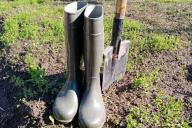Winter garlic attracts gardeners with its unpretentiousness and high productivity.
However, to get a quality harvest, it is necessary to provide garlic with suitable conditions. The most important element is the right soil.
Anastasia Kovrizhnykh, an expert of the online publication "BelNovosti" - a scientist agronomist, landscape designer, told how to act in such a situation.
Optimal soil for winter garlic
Winter garlic requires loose, fertile soil with good aeration. The most suitable option for it is loamy or sandy loam soil.
This composition allows air and moisture to be evenly distributed, which has a positive effect on the development of the root system.

The role of soil acidity
For proper garlic growth, the soil acidity level plays a key role.
The ideal indicator is a slightly acidic or neutral environment with a pH of 6-7. In the case of too acidic soil, it is recommended to apply lime to neutralize excess acidity.
Drainage and humidity
Stagnant water is extremely unfavorable for winter garlic. To avoid root rot, it is recommended to arrange high-quality drainage.
The soil should retain moisture, but not be too wet, as garlic prefers moderate moisture.
Fertilizers and Nutrients
Soil fertility is an important factor for producing strong and large heads of garlic.
It is recommended to prepare the soil in advance by adding organic fertilizers such as rotted manure or compost.
Garlic also responds positively to phosphorus-potassium fertilizers, which stimulate the formation of large cloves.
Preparing the soil before planting
Before planting winter garlic, it is necessary to carefully prepare the soil. The bed is dug to a depth of at least 25 cm, removing weeds and large stones. 2-3 weeks before planting, it is recommended to fertilize the soil with organic matter and let it settle.









